Feeling tired all the time? Picking up infections more often? These could be warning signs of a blood cancer brewing beneath the surface. Blood cancer, a broad term for cancers affecting your blood, bone marrow, or lymphatic system, can be a daunting topic. But fret not, this comprehensive guide will equip you with the knowledge to understand this condition.
Demystifying Blood Cancer: A Cellular Rebellion
Imagine your blood as a bustling city, with different types of blood cells playing crucial roles. Red blood cells are the oxygen taxis, white blood cells the valiant defenders, and platelets the road repair crew. Now, picture a rogue group of cells multiplying uncontrollably, disrupting the city’s order. This, in essence, is what happens in blood cancer. Mutations in the DNA of blood stem cells, the city’s originators, lead to the production of abnormal blood cells. These cancerous cells crowd out the good ones, hindering their vital functions.
Maruti Suzuki Swift 2024: Booking, features, launch date and price
2024 Bajaj Pulsar 125: Powerful bike with powerful updates!
The Diverse Landscape of Blood Cancers: Not a Monolith
Blood cancer isn’t a single entity, but an umbrella term for various types, each with its own characteristics:
-
Leukemia: This “raging storm” is the most common type, characterized by the rapid production of abnormal white blood cells. These abnormal cells are like rogue soldiers, unable to fight infections effectively.
-
Lymphoma: These cancers originate in the lymphatic system, a network of vessels and organs that help fight infection. Think of it as a rebellion within the city’s defense network. Lymphomas can be Hodgkin lymphoma, with the presence of specific cells, or non-Hodgkin lymphoma, a more diverse group.
-
Myeloma: This cancer specifically targets plasma cells, a type of white blood cell responsible for antibody production. Imagine the city’s communication system being disrupted, weakening its defenses.
-
Myeloproliferative Neoplasms (MPN): These cancers cause an overproduction of various types of blood cells, leading to imbalances and potential complications.
-
Myelodysplastic Syndromes (MDS): These are a group of conditions where the bone marrow malfunctions, producing immature or abnormal blood cells.
The Silent Alarm: Recognizing the Signs and Symptoms
Blood cancer can be sneaky, often presenting with vague symptoms that might be easily dismissed. However, being aware of these red flags can be crucial for early detection:
| Symptom | Possible Explanation |
|---|---|
| Fatigue | The abnormal cells might be hogging resources, leaving you feeling constantly drained. |
| Frequent Infections | The compromised immune system due to abnormal white blood cells makes you more susceptible. |
| Easy Bruising and Bleeding | Platelet dysfunction caused by cancer cells can lead to excessive bleeding. |
| Unexplained Weight Loss | The cancerous cells might be stealing energy from the body, leading to weight loss. |
| Swollen Lymph Nodes | These might be a sign of cancerous cells multiplying within the lymphatic system. |
| Night Sweats | This could be an indicator of the body’s attempt to fight the cancerous cells. |
Remember, these symptoms can be caused by other conditions too. However, if you experience any of them persistently, it’s best to consult a doctor for a proper diagnosis.
Early Detection is Key: Taking Charge of Your Health
Early detection is critical for successful blood cancer treatment. Here’s what you can do:
- Be aware of your body and any persistent changes.
- Schedule regular checkups with your doctor.
- Discuss your family history of cancer with your doctor.
- Don’t hesitate to ask questions and voice your concerns.
The Fight Within: Treatment Options for Blood Cancers
The good news is that advancements in medical science have led to a variety of effective treatment options for blood cancers. The specific treatment plan depends on the type and stage of the cancer, as well as your overall health. Here are some common approaches:
- Chemotherapy: Powerful drugs that target and destroy cancer cells. Think of it as a targeted missile strike against the rebels.
- Radiation Therapy: High-energy beams used to kill cancer cells or shrink tumors. Imagine it as a surgical strike with pinpoint accuracy.
- Stem Cell Transplants: Replacing diseased bone marrow with healthy stem cells, essentially rebuilding the city’s foundation.
- Immunotherapy: Harnessing the body’s immune system to fight cancer cells. Imagine training the city’s defense force to recognize and eliminate the rebels.
Living with Blood Cancer: Hope and Resilience
A blood cancer diagnosis can be overwhelming, but remember, you’re not alone. With proper treatment, support groups, and a positive attitude, you can manage the condition and live a fulfilling life. Here are some resources to help you navigate this journey:
- The Leukemia



